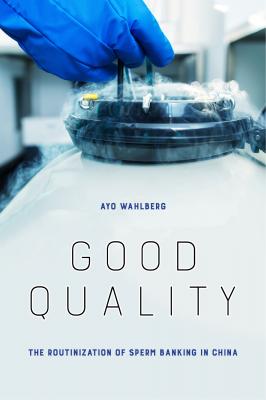Good Quality. Ayo Wahlberg
Чтение книги онлайн.
Читать онлайн книгу Good Quality - Ayo Wahlberg страница
 tion>
tion>
Good Quality
Good Quality
THE ROUTINIZATION OF SPERM BANKING IN CHINA
Ayo Wahlberg
UNIVERSITY OF CALIFORNIA PRESS
University of California Press, one of the most distinguished university presses in the United States, enriches lives around the world by advancing scholarship in the humanities, social sciences, and natural sciences. Its activities are supported by the UC Press Foundation and by philanthropic contributions from individuals and institutions. For more information, visit www.ucpress.edu.
University of California Press
Oakland, California
© 2018 by The Regents of the University of California
Library of Congress Cataloging-in-Publication Data
Names: Wahlberg, Ayo, author.
Title: Good quality : the routinization of sperm banking in China / Ayo Wahlberg.
Description: Oakland, California : University of California Press, [2018] | Includes bibliographical references and index. |
Identifiers: LCCN 2018006229 (print) | LCCN 2018006743 (ebook) | ISBN 9780520969995 (ebook) | ISBN 9780520297777 (cloth : alk. paper) | ISBN 9780520297784 (pbk. : alk. paper)
Subjects: LCSH: Sperm banks—China. | Sperm donors—China. | Artificial insemination—China. | China—Social life and customs.
Classification: LCC QP255 (ebook) | LCC QP255 .W28 2018 (print) | DDC 362.17/830951—dc23
LC record available at https://lccn.loc.gov/2018006229
26 25 24 23 22 21 20 19 18 17
10 9 8 7 6 5 4 3 2 1
For Helle, Mathias, and Jonas
Contents
1.The Birth of Assisted Reproductive Technology in China
2.Improving Population Quality
3.Exposed Biologies
4.Mobilizing Sperm Donors
5.Making Quality Auditable
6.Borrowing Sperm
Conclusion: Routinization
Coda
Notes
References
Index
Illustrations
FIGURES
1. Crowds congregate outside the CITIC-Xiangya Reproductive and Genetic Hospital
2. Site-multiplied, Hunan Sperm Bank provides donor sperm to fertility clinics around China
3. Lu Guangxiu and her father, medical geneticist Professor Lu Huilin
4. China’s first frozen sperm bank for humans, 1983
5. In March 1990, Professor Lu Guangxiu (left) successfully applied artificial insemination technology in Sichuan province where giant panda Wolong gave birth to a pair of twins
6. Smog descends on a street
7. Cryotanks at the sperm bank in Changsha
8. Men’s dormitories on university campuses are a favored recruitment site for sperm banks
9. Mobile sperm bank crew collecting donor sperm in Changde, Hunan Province
10. The waiting room for sperm donors
11. Private donor room for masturbation
12. The assembly line in the sperm bank laboratory
13. Preparing vials of qualified donor sperm for cryopreservation
14. Cryopreserving the day’s quality-controlled donations
TABLES
1.1. Annual IVF and insemination cycles carried out at the CITIC-Xiangya Reproductive and Genetic Hospital in Changsha
4.1. Record of daily first-time, second-time, and qualified donor donations and number of accepted semen samples in Changsha, May 2012
5.1. Number of screened candidates and qualified donors annually, Hunan Human Sperm Bank
Acknowledgments
As is so often the case, serendipity played its part in the making of this book. Had I not met Lu Guangxiu through my position as a research fellow on the European Commission–funded BIONET project in 2007, I would not have had the opportunity to visit her fertility clinic in Changsha and eventually to carry out ethnographic research at China’s oldest and largest sperm bank. Ever since my first visit to Changsha, capital of Hunan Province, in the fall of 2007, I have had my sights set on accounting for the astounding rise of a reproductive technology like sperm banking in China. I could not have done so without the help of a vast group of informants, colleagues, collaborators, assistants, friends, and family.
In Changsha, I owe special thanks to Professor Lu Guangxiu not only for her committed support of my research but also for her insistence that anthropological insights have value in medical settings like those found at the CITIC-Xiangya Reproductive and Genetic Hospital and the Hunan Sperm Bank. Changsha is my home away from home when I am in China thanks in large part to the hospitality of Lu Guangxiu and her family. A particular thanks to Lin Ge who has been supportive of my research